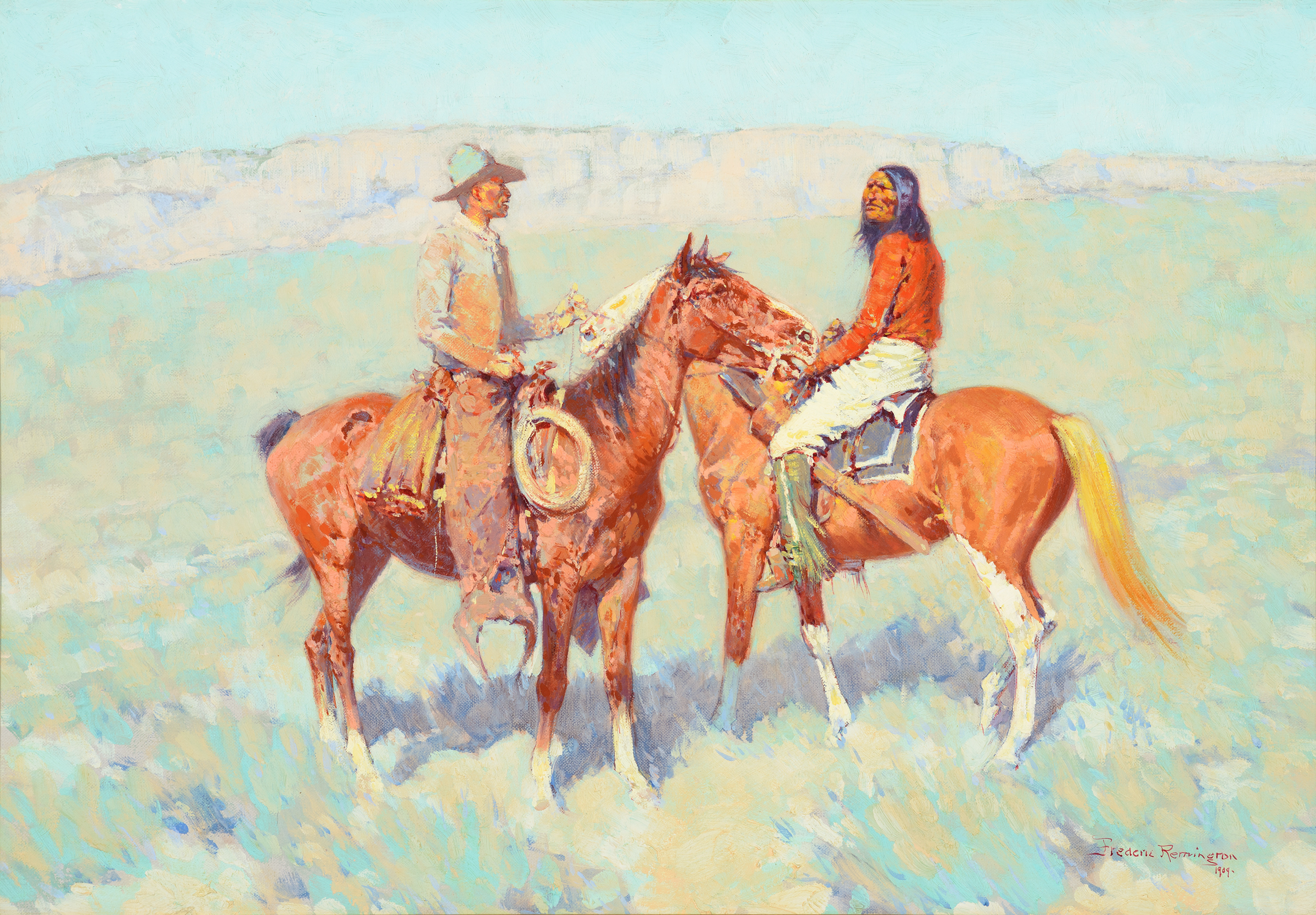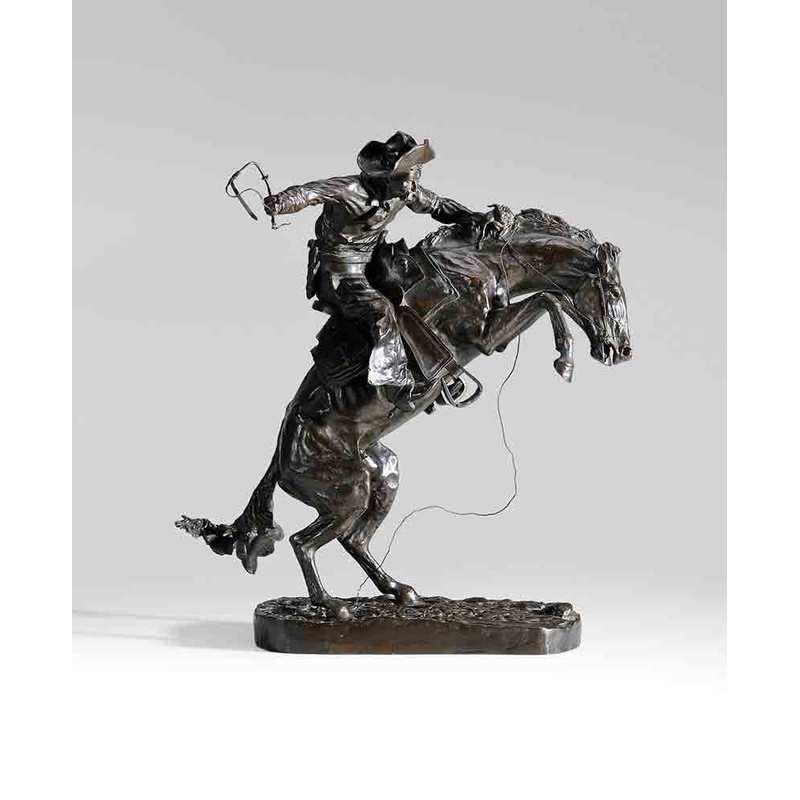
Step into the wild and rugged landscapes of the American frontier, where the spirit of the Wild West thrives in vivid colour and astonishing detail. Through the masterful strokes of his paintbrush, Frederic Remington has immortalized the essence of this bygone era, capturing the untamed beauty and untold stories of the American West. Join us on a journey through time as we delve into the life and legacy of this legendary artist, whose iconic artworks have become symbols of the American spirit. From his early days as a young artist to his rise as one of the most celebrated Western painters of all time, we uncover the remarkable stories behind Remington’s most famous pieces and their lasting impact on American art and culture. Prepare to be transported to a time of cowboys and Indians, vast prairies and thundering hooves as we explore how Remington’s art continues to captivate and inspire audiences even today.
The American Frontier: A brief historical background
The American Frontier, a vast and untamed land stretching from the Mississippi River to the Pacific Ocean, held a powerful allure for adventurers and settlers alike. It was a land of opportunity, where dreams could be realized, and fortunes won. The frontier was also a place of danger and hardship, where the clash of cultures between Native Americans and European settlers created an atmosphere of tension and conflict. Against this backdrop, Frederic Remington would come to find his inspiration.
Born in Canton, New York, in 1861, Remington grew up when the American West was still largely unexplored and untamed. As a boy, he developed a deep fascination with the stories of the frontier, devouring books and magazines that depicted the adventures of cowboys, Indians, and outlaws. This early exposure to the legends and lore of the West would shape Remington’s artistic vision and set him on a path to become one of the most renowned painters of the American frontier.
The life and career of Frederic Remington
From a young age, it was clear that Remington possessed a natural talent for art. His sketches and drawings showed a keen eye for detail and a knack for capturing the essence of his subjects. Encouraged by his family, Remington enrolled in the Yale School of Art, where he honed his skills and developed his unique style. However, Remington found his calling during a trip to the American West.
In 1881, at age 20, Remington embarked on his first journey to the West. The experience was transformative, exposing him to the vast landscapes, the rugged characters, and the epic tales that would become the subjects of his artwork. Remington’s time in the West was marked by adventure and danger as he travelled through frontier towns, witnessed buffalo hunts, and encountered Native American tribes. These experiences provided him with firsthand knowledge of the West, fueled his imagination, and inspired his artistic endeavours.
The inspiration behind Remington’s artwork
Remington’s art was driven by his desire to capture the spirit and essence of the American West. His paintings and sculptures depicted cowboys, Native Americans, soldiers, and wildlife, each telling a story and evoking a sense of adventure and awe. But what inspired Remington to create these iconic artworks?
For Remington, the American West represented a world of untamed beauty and unending possibilities. The vast landscapes, with their sweeping prairies, towering mountains, and endless horizons, served as a backdrop for his characters and narratives. With their rugged charm and fearless spirit, the cowboys embodied the essence of the frontier, while the Native Americans represented a proud and noble culture intimately connected to the land.
The techniques and style used by Remington
Remington’s art was characterized by his mastery of technique and ability to capture his subjects’ essence. He employed various mediums, including oil paints, watercolours, and bronze, to bring his visions to life. His use of colour and light added depth and vibrancy to his paintings, while his attention to detail and anatomy ensured that each character was rendered with accuracy and authenticity.
One of Remington’s signature techniques was his ability to convey movement and action in his artwork. Whether it was a cowboy riding a bucking bronco or a Native American warrior on horseback, Remington’s compositions were dynamic and energetic. He also had a keen eye for capturing the subtle nuances of expression and body language, allowing viewers to connect with his characters on a deeper level.
The significance of Remington’s artwork in preserving the American Frontier
Remington’s artwork played a pivotal role in preserving the memory and mythology of the American frontier. As the West rapidly changed and modernized, Remington’s paintings and sculptures were a visual record of a vanishing era. Through his art, he captured the essence of a time and place that was rapidly disappearing, ensuring that future generations would have a window into the past.
Moreover, Remington’s artwork also helped shape the popular perception of the American West. His depictions of cowboys and Indians, of vast open landscapes and dramatic sunsets, became the iconic images that defined the frontier. These images, in turn, influenced popular culture and shaped the collective imagination of what the American West represented.

Famous paintings by Frederic Remington
Remington’s work is vast and varied, encompassing hundreds of paintings and sculptures. Among his most famous pieces are “The Cowboy,” “The Bronco Buster,” and “The Fall of the Cowboy.” Each of these paintings captures the spirit of the American West and has become an enduring symbol of the frontier.
“The Cowboy” is perhaps Remington’s most iconic painting, depicting a lone cowboy on horseback, hat pulled low, staring off into the distance. The painting captures the solitude and ruggedness of the cowboy’s life while also hinting at the vastness and grandeur of the Western landscape. “The Bronco Buster,” on the other hand, showcases Remington’s talent for capturing movement and action. The sculpture depicts a cowboy struggling to tame a wild horse, showcasing the power and determination required to survive in the West.
Legacy and influence of Frederic Remington’s artwork
Remington’s artwork continues to captivate and inspire audiences to this day. His depictions of the American frontier have become iconic representations of the Wild West, influencing countless artists and filmmakers who have sought to capture the spirit of the West. Remington’s legacy can be seen in the works of artists such as Charles M. Russell and N.C. Wyeth, who followed in his footsteps and further contributed to the mythology of the frontier.
Remington’s influence also extends beyond the art world. His artwork has been featured in numerous museums and galleries across the United States, with dedicated exhibitions showcasing his contributions to American art. The Frederic Remington Art Museum in Ogdensburg, New York, houses an extensive collection of his works, allowing visitors to immerse themselves in the world of the American frontier.
Conclusion: Remington’s contribution to American art
Frederic Remington’s art remains a testament to the enduring legacy of the American frontier. Through his masterful brushstrokes and a keen eye for detail, he captured the Wild West’s spirit, beauty, and drama, immortalizing a bygone era for future generations. His artwork continues to inspire and captivate audiences, reminding us of the untamed landscapes and untold stories that shaped the American spirit. From canvas to legend, Frederic Remington’s contributions to American art are undeniable, ensuring that the spirit of the American frontier will forever live on.

